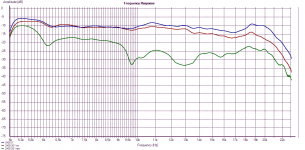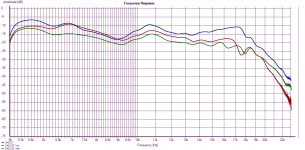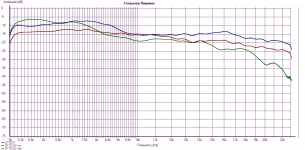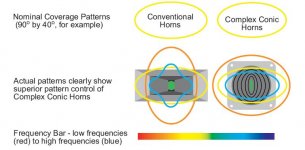Lips are added to mitigate the abrupt transition to free space that outbound waves 'see' when they exits the horn. Response ripple is induced by the attendant wave reflectance and diffraction.
Regards,
WHG
Sounds like an opportunity to add a second phase plug at the throat of the horn to make corrections.
Thoughts?
Hello,
Here is few pictures of Iwata - Le Cléac'h horns that I use to calulate.
IMG_7608_800.jpg Photo by i_should_coco | Photobucket
http://1.bp.blogspot.com/-ZrFxRRN3yfo/Uo8uarChHaI/AAAAAAAAGMs/IWHI3jJLaIU/s1600/Sytsem1.jpg
http://3.bp.blogspot.com/-Hg1o8kFac_g/Uo8usvNUuGI/AAAAAAAAGNU/ULvFM-NvLIE/s1600/Speaker1.jpg
Audiohagel - HIFI - Sound of Geeks
Audiohagel - HIFI - Sound of Geeks
The cloud of 40000 points was processed by Nicolas Davidenko who derived the data for the 3D machining tool.
Franck Delbauve built those magnificent horns using his 3D milling machine.
Best regards from Paris, France
Jean-Michel Le Cléac'h
Hello Jean-Michel,
Thanks to you, Nicolas and Franck! I am knocking on the door of the "sonic heaven".
Bass is a closed enclosure with 200 liter active crossed by 6th order Bessel tube filter.
In the mids work the JBL2482 with original phenolic diaphragm. Highs are feed by a Radian 475.
Mids and highs first order passive crossed yet.
The system is not yet finished. The frame for the 220Hz Iwata is an intermittent solution. This is a quick and dirty solution able to install the system on the ETF. And maybe I will check for the highs still a B&C DE220.
Bye and best regards Ralf aka raudi
Last edited:
Also, I wonder if continuing the phase plug for a few inches into the horn might help control dispersion.
I would love to get a chance to listen to these. Do you have any CSD plots for these horns individually?Hello,
T are 0.7 for both.
Fc of the largest one is 220Hz.
Fc of the smallest one is 600Hz (I possess a pair of those Iwata-JMLC 600 made of wood by Franck Delbauve for me).
Best regards from Paris, France
Jean-Michel Le Cléac'h
Do you have any CSD plots for these horns individually?
Hello,
I haven’t saved measurements. My friends and I performed some days before the ETF measurements only to get a short overview.
But you will find measurements of the 600Hz JMLC-Iwata in this thread. Imho the polish guys using the same contour for her 600Hz JMLC-Iwata.
A lot of the ETF members said, that the mids are very, very clean, detailed and not colored.
I am normally not a tube rolling guy. But as we test some different Telefunken RE604 and equivalents (Klangfim, Valvos and so on) in my friend (AlexK) amp, works for the mids and highs, we heart clear differences. Meaning the horns are able to reproduce smallest details.
Bye and best regards Ralf aka raudi
Yes
And there is a lot of unexplored territory here. Forming the parts may difficult because of the passage convolutions that may be introduced to meet a particular wave shaping mission. Note that passage walls become thin and fragile as their confluence is approached, so extending them beyond the driver body becomes perilous. Some early HF horn designs by Klipsch (see drawing) had vanes in the horn neck but they did not extend back into the phase plug. Of course, there are vintage designs by others as well.
Regards,
WHG
Also, I wonder if continuing the phase plug for a few inches into the horn might help control dispersion.
And there is a lot of unexplored territory here. Forming the parts may difficult because of the passage convolutions that may be introduced to meet a particular wave shaping mission. Note that passage walls become thin and fragile as their confluence is approached, so extending them beyond the driver body becomes perilous. Some early HF horn designs by Klipsch (see drawing) had vanes in the horn neck but they did not extend back into the phase plug. Of course, there are vintage designs by others as well.
Regards,
WHG
Attachments
Last edited:
Hello Rewind,
Those Iwata-JMLC horns provide the same acoustical load on the driver as the axisymetrical Le Cléac'h horns of the same cut-off and T value.
They also provide very low diffraction at their mouth, which is a feature that all Le Cléac'h horns have.
The quality of the sound is very much the same as with the axisymetrical Le Cléac'h horn, but due to the shape, the rate at which the radiation angle decreases with frequency in the horizontal plane with the Iwata-JMLC horn is half than with the axisymetrical Le Cléac'h horn, thus doubling the width of the sweet spot.
Due to the shape, the treble would benefit sometimes of some equalization, even if with good compression drivers as the TAD TD2001 the slightly decreasing response in the high frequency (over 3500HZ roughly) aproximates the desired frequency response curve for small auditoriums.
Best regards from Paris, France
Jean-Michel Le Cléac 'h
Interesting!
Do the Iwata-JMLC horns exhibit the "pattern flip" of wide-aspect exponentials (Altec sectorals, etc.), or has this problem been solved? That alone would be a considerable achievement.
Some early HF horn designs by Klipsch (see drawing) had vanes in the horn neck but they did not extend back into the phase plug. Of course, there are vintage designs by others as well.
Regards,
WHG
Bill
Fascinating link, thanks.
It seems that most of the LeCleac'h horns for sale are designed with the parameter T=.8.
Why is that, when T=.7 is said to give better loading?
Is it a compromize between T=.7 and T=1 of a typical phase plug?
Trying to keep the horn short enough to ship?
(A longer horn would be easier to time align with a bass horn.)
Is it easier to cross over?
Something else?
Why is that, when T=.7 is said to give better loading?
Is it a compromize between T=.7 and T=1 of a typical phase plug?
Trying to keep the horn short enough to ship?
(A longer horn would be easier to time align with a bass horn.)
Is it easier to cross over?
Something else?
Mackie are using vanes in the horn throat, too. You can see them when you look in. From what they say in their literature, they go all that way back to the phase plug to avoid reflections. If we can believe the published polars, they work very well indeed!Some early HF horn designs by Klipsch (see drawing) had vanes in the horn neck but they did not extend back into the phase plug.
C300z :
Vanes is a great idea if that kind of pattern is desirable, but you still are effected by the mouth. Expanding coverage angle at higher frequencies make make lip design more critical because you now have more high frequency energy near the lip.
Interesting!
Do the Iwata-JMLC horns exhibit the "pattern flip" of wide-aspect exponentials (Altec sectorals, etc.), or has this problem been solved? That alone would be a considerable achievement.
Hello Lynn,
Pattern flip is generally associated with a wanted diffraction.
As an example, why the slot of tweeters like JBL2405 or TAD TD703 must be oriented vertically is to obtain their largest spreading Inside the horizontal plane.
EXCLUSIVE ET-703
Iwata-JMLC and E-JMLC horns don't use such kind of diffraction to control directivity. Their directivity in the vertical plane is higher than in the horizontal plane. There is no pattern flip.
Examples with the E-Jmlc horn :
see directivity sonogram of the E-JMLC300
Horns
half upper part horizontal half bottom part vertical
and for the E-JMLC1000 (left horizontal directivity sonogram, right vertical directivity sonogram).
Horns
Best regards from Paris, France
Jean-Michel Le Cléac'h
Pattern flip is generally associated with a wanted diffraction.
Hi Jean-Michel,
Even without diffraction pattern flip cannot be avoid when one dimension is smaller than the other. It is just a matter of keeping it lower than the intended crossover, or accept some form of vertical beamwidth widening (and loss of matching) at the crossover point (as most horn speakers do...).
As an example, why the slot of tweeters like JBL2405 or TAD TD703 must be oriented vertically is to obtain their largest spreading Inside the horizontal plane.
This is clearly the case for the 2405, as well as the 2403/076 "cat eye" (up to 17kHz), but not for the ET703 (at least not past 8kHz...). Contrary to most pictures that can be found on the web, and the way it was used in the L300 exclusive clone (can't remember its name), the ET703 is best used with the "slot" (horn) horizontal.
Here are some raw directivity measurements (the 30° angle is approximative...) with the "correct" orientation
2405 (vertical slot)
2403 (vertical slot)
ET703 (horizontal horn, ie not the common presentation)
Attachments
Last edited:
soongsc - yes I agree, the mouth will still make a significant difference. It appears that Mackie have done work in that area, too. Have a look at their speakers. For example:
http://www.mackie.com//products/c300z/images/front.jpg
Not perfect, but certainly a good effort for the size of the box.
http://www.mackie.com//products/c300z/images/front.jpg
Not perfect, but certainly a good effort for the size of the box.
Even without diffraction pattern flip cannot be avoid when one dimension is smaller than the other.
Hello Pos,
I don't rely on simplistic empirical formulas as the one given by Keele in 1975
Understanding Horn Directivity Control Synergetic Audio Concepts
expressing the frequency at which the horn loose directivity control versus the widthor height of the mouth of the horn. It dépends a lot on the shape of the lips of the mouth and the way the wavefront "drag" along the walls of the horn until the mouth.
Even a "wavetank" as in Hornresp can shows that directivity in the low frequencies reproduced by a horn are much influenced by the shape of the mouth and not only by its width / height ratio.
Iwata-JMLC and E-Jmlc horns behave luch more like the complex conic horn described by Renkus-Hein
http://www.fullcompass.com/common/files/14314-trx121.pdf
which doesn't lead to "pattern flip" (see attachment @ Renkus-Hein taken from the document above).
A conventional horn showing pattren flip on left, a modern horn which doesn't lead to " pattern flip" on right, this one having few similarities with the Iwata-JMLC horn).
Best regard from Paris, France
Jean-Michel Le Cléac'h
Attachments
Last edited:
Hello Jean-Michel,
Thanks to you, Nicolas and Franck! I am knocking on the door of the "sonic heaven".
Bass is a closed enclosure with 200 liter active crossed by 6th order Bessel tube filter.
Interesting,
What speaker for the bass?
Conjecture
If all pattern control (wave front spreading) gymnastics were accomplished in the phase plug passage geometry before passage transverse dimensions become comparable to the wave length of the highest frequency to be passed then:
1) the phase plug passage confluence geometry would be the sole determinate of the extent of a frequency independent uniform coverage in the far field
2) the remaining horn body would simply continue guiding expansion of this wave front profile already established
3) curled back lips at the horn mouth would be added solely to mitigate the effects of reflectance and diffraction.
If I had an acoustics lab & NC machining center at my disposal, this is what I would be working on. For now, it is just an 'acoustic dream' for me. There is no doubt in my mind that Mackie is on the right 'path'.
Regards,
WHG
Mackie are using vanes in the horn throat, too. You can see them when you look in. From what they say in their literature, they go all that way back to the phase plug to avoid reflections. If we can believe the published polars, they work very well indeed!
C300z :
If all pattern control (wave front spreading) gymnastics were accomplished in the phase plug passage geometry before passage transverse dimensions become comparable to the wave length of the highest frequency to be passed then:
1) the phase plug passage confluence geometry would be the sole determinate of the extent of a frequency independent uniform coverage in the far field
2) the remaining horn body would simply continue guiding expansion of this wave front profile already established
3) curled back lips at the horn mouth would be added solely to mitigate the effects of reflectance and diffraction.
If I had an acoustics lab & NC machining center at my disposal, this is what I would be working on. For now, it is just an 'acoustic dream' for me. There is no doubt in my mind that Mackie is on the right 'path'.
Regards,
WHG
Last edited:
Hello Jean-Michel taken the same T value and same cutoff frequency, what audible differences do have you experienced using an axisymmetrical design vs the Iwata type design with the same driver?
Interesting,
What speaker for the bass?
Hello Nicolas,
it’s a Fostex FW405N with 950µF in series.
Enclosure its damped on down and top end with each 30cm thick rock wool behind 25 cm Basotect to suppress the longitudinal wave.
Some more pictures you can find here.
Bye and best regards Ralf aka raudi
Hello Pos,
I don't rely on simplistic empirical formulas as the one given by Keele in 1975
Understanding Horn Directivity Control Synergetic Audio Concepts
expressing the frequency at which the horn loose directivity control versus the widthor height of the mouth of the horn. It dépends a lot on the shape of the lips of the mouth and the way the wavefront "drag" along the walls of the horn until the mouth.
Even a "wavetank" as in Hornresp can shows that directivity in the low frequencies reproduced by a horn are much influenced by the shape of the mouth and not only by its width / height ratio.
Iwata-JMLC and E-Jmlc horns behave luch more like the complex conic horn described by Renkus-Hein
http://www.fullcompass.com/common/files/14314-trx121.pdf
which doesn't lead to "pattern flip" (see attachment @ Renkus-Hein taken from the document above).
A conventional horn showing pattren flip on left, a modern horn which doesn't lead to " pattern flip" on right, this one having few similarities with the Iwata-JMLC horn).
Best regard from Paris, France
Jean-Michel Le Cléac'h
Excellent to see this pointed out!
A few months back I was experimenting with the wavefront simulator in Hornresp, and noticed that a roundover at the mouth changed the radiation of the horn, even at frequencies that are shorter than the dimensions of the mouth.
In other words, I'd expected that a roundover was only effective at the lowest frequencies of a horns bandwidth. But the wavefront simulator seems to indicate that a roundover helps in the midrange too.
Thread is here :
http://www.diyaudio.com/forums/multi-way/243609-most-horns-fundamentally-flawed.html
- Home
- Loudspeakers
- Multi-Way
- Jean Michel on LeCleac'h horns



